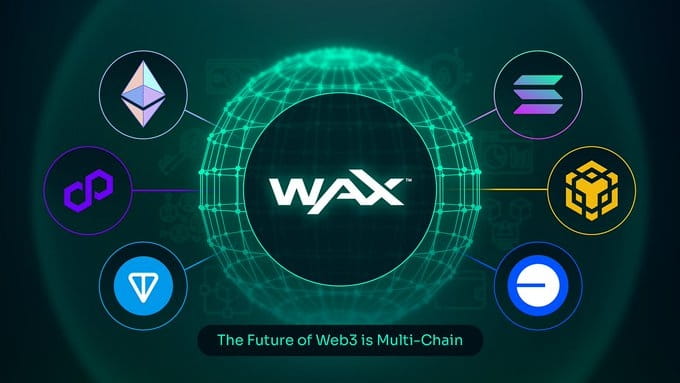
With the continued evolution of the Web3 space, one trend is becoming increasingly clear: there will not be a single dominant blockchain.
On the contrary, the future of cryptocurrencies, NFTs, games, and decentralized applications will rely on multiple blockchains working together, each contributing its unique value. From the strong liquidity of Ethereum to the speed and efficiency advantages shown by WAX, no single network can excel in every aspect. This is why cross-chain functionality is particularly critical.
What is cross-chain and why is it so important?
Cross-chain (or multi-chain) technology refers to the ability to transfer assets, data, or functions between different blockchain networks. Currently, there are dozens of popular blockchains, and users and developers need tools that can connect these ecosystems, rather than being confined to a single specific blockchain.
Without cross-chain solutions, users would be in a bind. Digital currencies, NFTs, and data would be isolated, and transferring between ecosystems would not only be cumbersome and frustrating, but often fraught with risks.
Cross-chain infrastructure solves this problem by achieving interoperability between blockchains. Think of it as the internet finally mastering a universal language that allows users and developers to freely traverse different platforms, bringing new possibilities for innovation, liquidity, and user experience.
Different chains, different advantages
No blockchain is perfect, but each blockchain has its unique value:
Ethereum has the richest liquidity and a wide variety of DeFi tools, but its transaction speeds are usually slow and costs relatively high.
WAX is optimized for NFTs, games, and real-world applications, with astonishing transaction speeds.
Solana features high throughput and speed, making it an ideal choice for certain types of applications.
Polygon brings scalability to Ethereum compatibility.
TON integrates with Telegram, opening up new application channels.
Attempting to achieve all functionalities on a single chain is neither realistic nor cost-effective. Cross-chain technology allows you to integrate the advantageous features of each ecosystem to create better applications and user experiences.
Why cross-chain is the future of Web3
Here are the reasons why cross-chain is not just a passing trend:
1. More users, broader access
Cross-chain bridges effectively eliminate barriers for users transferring assets between different chains. Users can bring assets from one chain to another, try new applications, and enter ecosystems that may have been overlooked. This means an increase in the number of new users and comprehensive growth of the overall business.
2. Better Liquidity
The prosperity of DeFi, NFTs, and the digital currency economy relies on liquidity. The ability to transfer assets between blockchains ensures that value is not trapped within a single network, allowing projects to access a broader market without having to rebuild from scratch.
3. Composable Applications
Developers can build smarter DApps while calling resources from multiple chains. For example, do you want to use Ethereum's stablecoin in a WAX game? Or launch a marketplace that accepts Solana, BNB, and Polygon digital currencies? With cross-chain technology, these are not only possible but highly anticipated.
4. Aiming for the Future
The rise and fall of blockchains happen frequently, and new technologies are constantly emerging. However, if your project has cross-chain compatibility, it can maintain flexibility and adaptability regardless of how the industry landscape changes in five years.
How WAX integrates into the cross-chain future
WAX has always focused on practical applications: creating fast transactions and useful tools for real users. However, even the most efficient blockchain needs a way to connect broadly with the outside world, and this is where the WAX Cloud Wallet Cross-Chain Bridge plays its role.
Understanding the Cloud Wallet Cross-Chain Bridge
The Cloud Wallet Bridge enables easy asset transfers between WAX and other major blockchains. Currently, it supports the following blockchains:
Solana
Ethereum
Polygon (and Polygon zkEVM)
BNB Smart Chain
Base
TON
It is directly integrated into the WAX Cloud Wallet, meaning that both first-time users and seasoned developers can easily achieve asset bridging without crossing technical barriers. The entire experience is smooth and intuitive, perfectly integrated into the larger WAX ecosystem.
Visit https://bridge.mycloudwallet.com to experience it.
Practical application cases of cross-chain on WAX
Cross-chain is not just a theoretical concept; it can now unleash the potential of new practical tools:
Cross-chain rewards and airdrops: Airdropping digital currencies or NFTs to wallets on other chains to attract new users into the WAX ecosystem.
DeFi on WAX: Building liquidity bridges from other ecosystems to WAX, enabling users to stake, trade, and more.
Web3 games covering the globe: Allowing players to bring digital currencies and assets from any chain into WAX-powered games.
No longer a competition between chains
The old model of blockchain competition is gradually fading away. Moving forward, collaboration through connectivity is key. Projects that actively embrace cross-chain will develop more rapidly, reach a wider user base, and create better products. Projects that ignore cross-chain are likely to fall behind.
WAX is fully prepared for the future—tools like the Cloud Wallet Cross-Chain Bridge make the future a reality.
Join the WAX community!
Official website: https://www.wax.io
X/Twitter: https://x.com/WAX_io
Discord: https://go.wax.io/Discord
Cloud Wallet: www.mycloudwallet.com
*Note: This article is for informational purposes only and does not constitute any investment advice!
